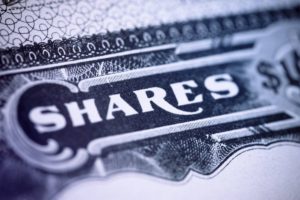INVESTING: WHAT IS A COMMON STOCK?
 Source: CBS News
Source: CBS News
If you had the chance to read the introduction to the Investor's education, you are already familiar with the roadmap to stock market trading knowledge.
Today, I am starting with the basics, and it is the company’s “common stock”.
As it is known to informed investors, the common stock is a security that represents ownership in a corporation. Holders of common stock exercise control by electing a board of directors and voting on corporate policy.
But before we will go further, let’s identify the most known types of stocks the company has the right to issue:
- Bonds (debt securities)
- Senior shares
- Preferred shares
- Common shares
As you see, the common shares are at the bottom of the priority ladder in terms of ownership structure. With common stock, if a company goes bankrupt, the common stockholders do not receive their money until the creditors and preferred shareholders have received their respective share of the leftover assets.
Is it good or bad?
The good: common shares usually outperform bonds and preferred shares in the long run.
The bad: common stocks are riskier than debt or senior/preferred shares.
In accordance with Investopedia, “the first-ever common stock was established in 1602 by the Dutch East India Company and introduced on the Amsterdam Stock Exchange.”
When you buy the stock as a shareholder, you become an owner of a slice of the company equal to the number of shares (held as a proportion of the company's total outstanding shares). For instance, an individual or entity that owns 50,000 shares of a company with 5 million outstanding shares would have a 1.0% ownership stake in it. Most companies have outstanding shares that run into the millions or billions.
 Source: Parsonage Fin Planning
Source: Parsonage Fin Planning
Why a Company Issues Shares
Here is a simple question: why does the company want to trade its own shares on the stock market? You guess it right – to get additional capital. That capital, (obtained when the traders like yourself or larger like investment institutions buy the shares and become shareholders), can be used to invest in research and development, pay off the debt, purchase another company, etc.
When the company is growing, it requires plenty of additional capital, and that capital can be obtained from the banks. However, when a company establishes itself and needs to rapidly expand, it may need access to much larger amounts of capital than it can get from its own operations or a traditional bank loan. In that case, the company obtains the capital through trading the ownership shares on the stock market by issuing the stock shares.
A common way to issue the shares:
UNDERWRITER --> IPO --> STOCK MARKET (NASDAQ, NYSE)
Another way to issue shares:
DPO --> advertisement --> STOCK MARKET (OTCBB, pick sheets)
For a company to issue stock, it must begin by having an initial public offering or IPO. To begin the IPO process, a company must work with an underwriting investment banking firm (like Goldman Sacks or Morgan Stanley), which helps determine both the type and pricing of the stock. After the IPO phase is completed, the general public is allowed to purchase the new stock.
Once the company's shares are listed on a stock exchange and trading in it begins, the price of these shares will fluctuate as investors and traders evaluate and reevaluate their essential value.
Larger U.S.-based stocks are traded on a public exchange such as the New York Stock Exchange (NYSE) with about 2800 stocks listed or NASDAQ with about 3300 stocks listed. NYSE has a market capitalization of ~$30 trillion, making it the biggest stock exchange in the world by market cap.
There are also several international exchanges for foreign stocks, such as the London Stock Exchange and the Tokyo Stock Exchange. Companies that are smaller in size and unable to meet an exchange’s listing requirements are considered unlisted. These unlisted stocks are traded on the Over-The-Counter Bulletin Board (OTCBB) or so-called “pink sheets”.
With a direct public offering (DPO), a company offers its securities directly to the public to raise capital by eliminating the middlemen (i.o. investment banks, broker-dealers, and underwriters).
Cutting out the intermediaries from a public offering substantially lowers the cost of capital of a DPO that is a great advantage for small-size companies. Since the DPO goes without multiple restrictions of SEC, banks, or venture capital investing, the issuer of shares establishes the number of shares and the price per share on its own. However, in this case, the DPO shares can be traded only on secondary markets like OTCBB as it does not follow the SEC requirements.
Are all shares of the company being offered to the public?
Good question!
The answer is NO. First of all, as a common practice, the company offers some number of shares to the underwriting company for its service. Secondly, it often leaves some number of shares to its officers (“ownership shares” for CEO, CFO, Directors, etc.). The rest of the common shares are called “outstanding shares” are being offered for trading.
As soon as the IPO stock begins trading, the company sells the shares and gets some capital back. The initial price for IPO is determined by the underwriting company, but at the end of the first trading day, the stock’s price may significantly deviate from the initial IPO price.
The company can also issue shares of other categories of stocks or bonds to raise capital.
There are several types of stocks.
- Growth stocks are companies that tend to increase in value due to growing earnings.
- Value stocks are companies lower in price in relation to their fundamentals. Value stocks offer a dividend, unlike growth stocks.
- Stocks are also categorized by market capitalization - either large, mid or small. Large-cap stocks are much more heavily traded and are generally an indication of a more stable company. Small-cap stocks are usually newer companies looking to grow, so they can be much more volatile compared to large caps. Stocks should be considered an important part of any investor’s portfolio.
Advantages and Disadvantages of Public Companies
Once the company began trading the shares on the stock market, it is not a private company anymore – it becomes a “public” company. As always, there are some pros and cons to becoming a public company.
Pros:
- Public companies sell future equity stakes and increase access to debt markets. Once a company goes public, additional offerings generate revenue through the creation and sale of new shares in the marketplace. Whenever the company needs more capital, it can issue new shares (although, the investors don’t like it as the value per share drops).
Cons:
- Increased regulatory scrutiny and less control for majority owners and company founders.
- Public companies must meet mandatory reporting standards regulated by government entities (i.e. SEC - The U.S. Securities and Exchange Commission). In addition, each stock exchange has its own standards and requirements.
- The management must report about the company’s business activities. All major shareholders and the management must report about purchasing/sale of the shares.
- The company’s business also depends on relationships with its shareholders since they owe the company’s shares. By voting, the shareholders may approve or disapprove of the changes or any proposed activities offered by the management.
NEXT TOPIC: SENIOR AND PREFERRED STOCKS.
If you like what you read and want to be notified about future articles, please subscribe for FREE (at the bottom of a page)
